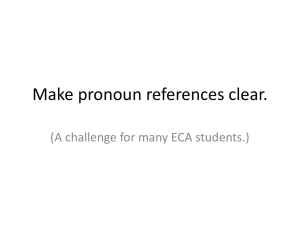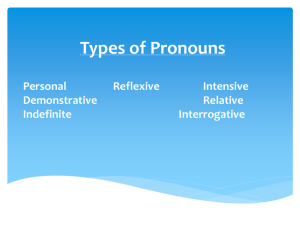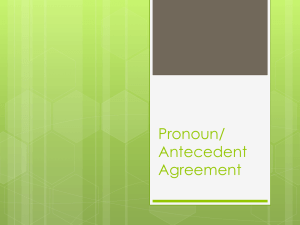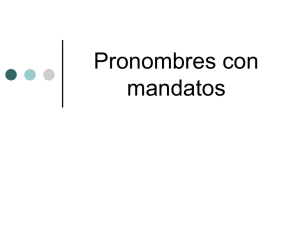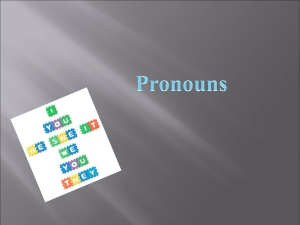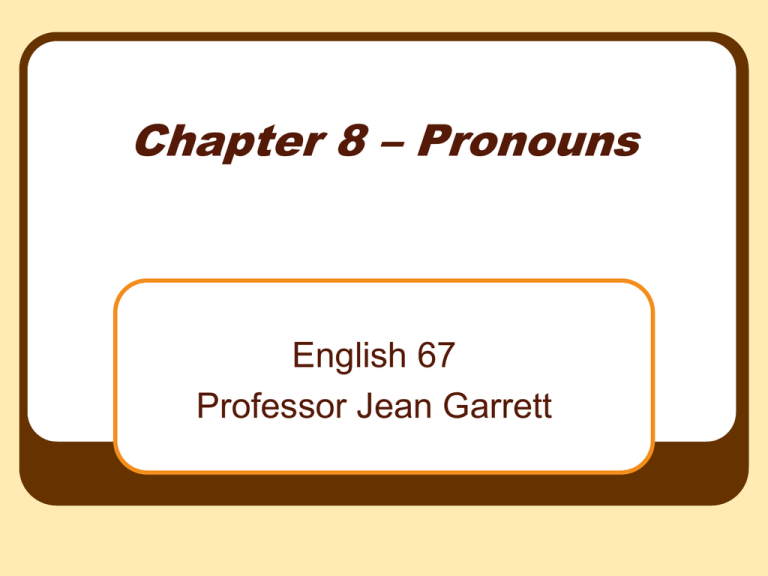
Chapter 8 – Pronouns
English 67
Professor Jean Garrett
Pronoun Agreement
A pronoun must agree with its
antecedent (noun or pronoun it
replaces) in:
• person
• number
• gender
Pronoun Agreement: Person
A pronoun agrees with its antecedent
(noun or pronoun it replaces) in person.
Person--first, second or third--indicates
perspective or point of view.
Singular
Plural
Relative
1st person
I, me
we, us
who, whoever
2nd person
you
you
3rd person
he, she, it
him, her
they
them
who, whoever
Pronoun Agreement: Person
Avoid needless shifting in person,
which means shifting in point of view,
such as from I to you.
• I was having trouble, for you could see
•
disaster ahead. [Needless shift from first
person to second person.]
I was having trouble, for I could see disaster
ahead. [Consistent use of first person point
of view.]
Pronoun Agreement: Person
• When students are having trouble with
grammar, you should seek help from the
Writing Center.
[Needless shift from third person to second
person.]
• When students are having trouble with
grammar, they should seek help from the
Writing Center.
[Consistent use of third person point of view.]
Pronoun Agreement: Person
•
•
•
If you find that you hate your job, one should
consider changing his or her profession.
[Needless shift from second person to third person.]
If you find that you hate your job, you should
consider changing your profession.
[Consistent use of second person point of view.]
If people find that they hate their jobs, they should
consider changing their professions.
[Consistent use of third person point of view.]
Pronoun Agreement: Number
A pronoun agrees with its antecedent
(noun or pronoun it replaces) in
number.
Most problems with pronoun-antecedent
agreement involve number.
There are eleven rules to apply in order for
pronouns to agree with their antecedent .
Pronoun Agreement: 11 Rules
1. A singular antecedent requires a
singular pronoun.
•
•
Hoang forgot his notebook.
Someone lost his or her textbook.
2. A plural antecedent requires a plural
pronoun.
•
•
Many students cast their [not his or her]
votes today.
We wanted to have our party in the park.
Pronoun Agreement: 11 Rules
3. A singular indefinite pronoun as an
antecedent takes a singular pronoun.
Most indefinite pronouns are singular.
They often end with -body, -one, or –thing
or include each, either, and neither.
•
•
Each of the girls brought her [not their]
book.
When someone makes a promise, he or
she [not they] should keep it.
Pronoun Agreement: 11 Rules
4. A plural indefinite pronoun as an antecedent
takes a plural pronoun.
•
Few knew their assignments.
5. Some indefinite pronouns do not clearly
express either a singular or plural number, so
agreement depends on the meaning of the
sentence. These pronouns are all, any, none,
and some.
•
•
All of the apple was good. [All means one.]
All of the apples were gone. [All means many.]
Pronoun Agreement: 11 Rules
6.
•
•
7.
•
•
Two or more antecedents, singular or plural, take a plural
pronoun. Such antecedents are usually joined by and or
by commas and and.
Melinda and her friends bought their tickets early.
Voters, campaigners, and the candidate celebrated their
victory at the election party.
Alternative antecedents, such as antecedents joined by
or, nor, whether/or, either/or, neither/nor, not only/but
also, require a pronoun that agrees with the nearer
antecedent.
Neither Allen nor his classmates found their test difficult.
Neither his classmates nor Allen found his or her test
difficult.
Pronoun Agreement: 11 Rules
8. In a sentence with an expression such as one
of those ___ who, the antecedent is usually
the plural noun that follows.
•
She is one of those actors who want their personal
lives to be kept private.
9. In a sentence with the expression the only
one of those ___ who, the antecedent is
usually the singular word one.
•
She is the only one of the actors who wants her life
to be kept private.
Pronoun Agreement: 11 Rules
10. When collective nouns such as team, jury,
committee, and band are used as
antecedents, they take a singular pronoun
if they are considered as units.
•
•
The team is doing its best to win the homecoming
game.
The band is playing its best songs to win the
competition.
When individual behavior is suggested,
antecedents take a plural form.
•
•
The team are packing their suitcases for the state
finals.
The band found out that their new uniforms do not fit.
Pronoun Agreement: 11 Rules
11. The words each, every, and many
before a noun make the noun singular.
•
•
•
Each boy and girl was responsible for
bringing his or her lunch.
Each and every person doubted himself or
herself.
Many a person is capable of knowing himself
or herself.
Pronoun Agreement: Gender
If the gender of the antecedent is
specific, the pronoun should agree
with its antecedent in gender.
Masculine and feminine pronouns are
gender-specific: he, him, she, her.
•
•
Mike gave us his opinion.
Maria bought her first house.
Pronoun Agreement: Gender
•
Others are neuter: I, we, me, us, it, they,
them, who, whom, that, which.
•
•
•
The boys were tired from bus trip, so they went
straight to the hotel.
The women were very happy the award was
presented to them.
The pronouns who and whom refer to people.
•
•
He is the friend whom I like the best.
She is the suspect who robbed the bank.
Pronoun Agreement: Gender
•
•
That can refer to ideas, animals, and
things but does not refer to individuals.
•
This is the dog that we found.
Which refers to ideas and things but not
to people.
•
The movie which we saw was the one we
discussed in class.
Pronoun Agreement: Gender
•
To avoid a perceived sex bias, you can use
he or she or his or her instead of just he or
his.
•
•
Everyone should revise his or her essay very
carefully.
Because the repetition of he or she and his
or her several times in a sentence can get
awkward, many writers simply make
antecedents and pronouns plural.
•
Students should revise their essays very
carefully.
Pronoun Agreement: Gender
•
In either case, avoid using a plural pronoun
with a singular indefinite pronoun; such
usage violates the basic principle of
pronoun agreement.
•
•
•
Incorrect: Everyone should do their homework
consistently.
Correct: Everyone should do his or her
homework consistently.
Correct: All students should do their
homework consistently.
Pronoun Reference
•
•
•
A pronoun must refer clearly to its antecedent.
Because a pronoun is a substitute word, it can
express meaning clearly and definitely only if
its antecedent is easily identified.
In some sentence constructions, gender and
number make the reference clear.
•
•
Dimitri and Poloma discussed his absences and her
good attendance. [gender agreement]
If the three older boys in the club carry out their plans,
it will break up. [number agreement]
Pronoun Reference
•
•
However, always avoid ambiguous reference.
The following sentences illustrate the kind of
confusion that results from structuring
sentences with more than one possible
antecedent for the pronoun.
•
•
•
•
Unclear: Kim gave David his money and clothes.
(Both are male names.)
Clear: Kim gave his own money and clothes to
David.
Unclear: Sarah told her sister that her car had a flat
tire.
Clear: Sarah said to her sister, "Your car has a flat
tire."
Pronoun Reference
•
•
•
When using a pronoun to refer to a general
idea, make sure that the reference is clear.
The pronouns used frequently in this way are
this, that, which, and it.
The best solution may be to rewrite the
sentence to omit the pronoun in question.
•
•
•
Unclear: Gabriella whistled the same tune over and
over, which irritated me.
Clear: Gabriella whistled the same tune over and
over, a habit that irritated me.
Clear: Her whistling the same tune over and over
irritated me.
Goodbye!!
Pronoun Agreement
A pronoun agrees with its antecedent (noun
or pronoun it replaces) in number, person,
and gender.
{antecedent}
Example: Neither of the girls could find (her, their) lost
earrings.
Example: Neither of the girls could find her lost
earrings.
(Neither is singular so the pronoun her should also be singular.)

